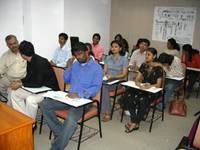:Six Sigma for Business Excellence:
If there is one word to describe the Mumbai STC session on Six Sigma for Business Excellence, it is “fantastic”. A group of technical writers had gathered at US Interactive on 19th February to learn about Six Sigma. Mr. Pavan Kumar Garikapati, a software quality professional with the Six Sigma cell at Patni, conducted the session.
The session started with identifying the need for Six Sigma implementation. The primary challenges for companies include retaining customers, controlling product quality, and cutting down costs to survive in the global competition. Companies need to remember the three C’s; namely, Customer, Competition, and Change while producing quality products.
Six Sigma is a disciplined, data-driven approach and methodology for eliminating defects (driving towards six standard deviations between the mean and the nearest specification limit) in any process. Six Sigma is a proven technique to achieve defect level of 3.4 PPM (parts per million) in production. It is a method to implement breakthrough improvements in terms of cost, quality, and delivery.
Pavan explained how Six Sigma evolved in Motorola and GE. Motorola followed the PTA (Project, Training, and Apply) method while GE followed a more philosophical approach for Six Sigma implementation. Motorola placed a high importance on training employees. GE stressed that the internal rate of change should be greater than the external rate of change.

The Attendees
Six Sigma is also a tool, a metric, and a business strategy to keep defects limited to 3.4 PPM. Six Sigma is truly a challenge, but companies have successfully implemented it. To think of it, the Mumbai dabbawala services are rated at a level greater than Six Sigma.
The session got a bit complex at this point with Pavan explaining the statistical representation of Six Sigma. Product defects can be calculated by studying the output characteristics using a frequency distribution graph. Six Sigma is implemented using the DMAIC (Define, Measure, Analyze, Improve, Control) methodology.
The personnel structure for Six Sigma includes a Master Black Belt (MBB) at the top who mentors the Six Sigma implementation in any organization. A number of Black Belts (BB) report to the MBB. The BBs typically handle 4 to 5 different projects. The BBs supervise a number of Green Belt (GB) professionals who manage different teams. These teams comprise of Yellow Belt (YB) or White Belt (WB) professionals.
Pavan concluded the session by discussing a case study of Six Sigma implementation at Patni.
The session got a bit complex at this point with Pavan explaining the statistical representation of Six Sigma. Product defects can be calculated by studying the output characteristics using a frequency distribution graph. Six Sigma is implemented using the DMAIC (Define, Measure, Analyze, Improve, Control) methodology.
The personnel structure for Six Sigma includes a Master Black Belt (MBB) at the top who mentors the Six Sigma implementation in any organization. A number of Black Belts (BB) report to the MBB. The BBs typically handle 4 to 5 different projects. The BBs supervise a number of Green Belt (GB) professionals who manage different teams. These teams comprise of Yellow Belt (YB) or White Belt (WB) professionals.
Pavan concluded the session by discussing a case study of Six Sigma implementation at Patni.

(L to R) Vidyut, Meghashri, Pavan
At the end of the session, all of us were left pondering how Six Sigma can be successfully implemented in technical writing.
Report courtesy Swapna Shirwalkar
Report courtesy Swapna Shirwalkar
No comments:
Post a Comment